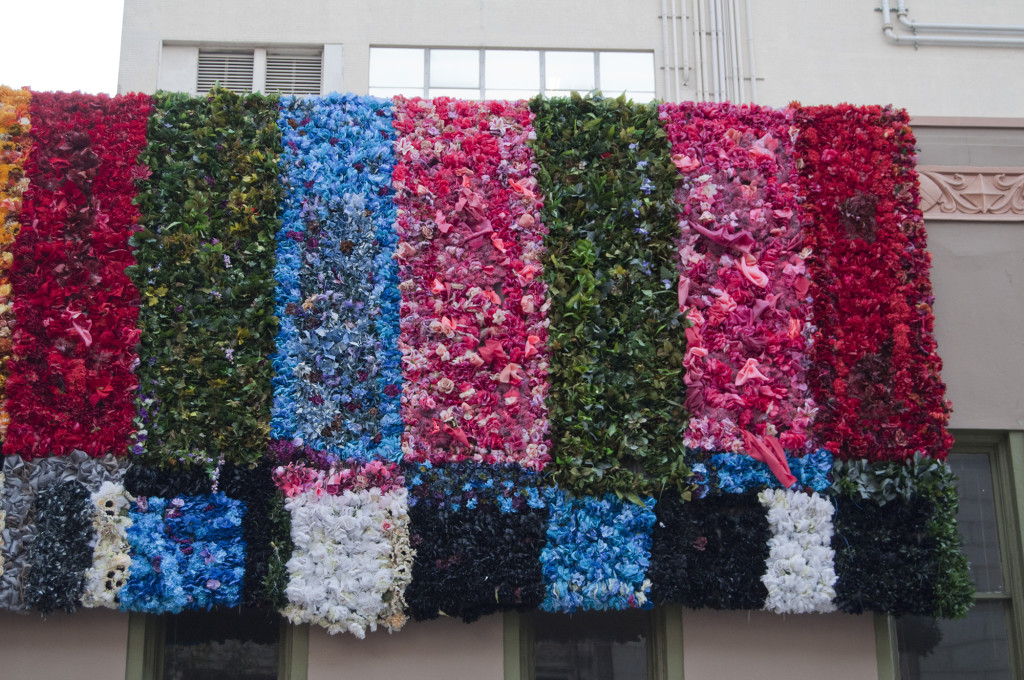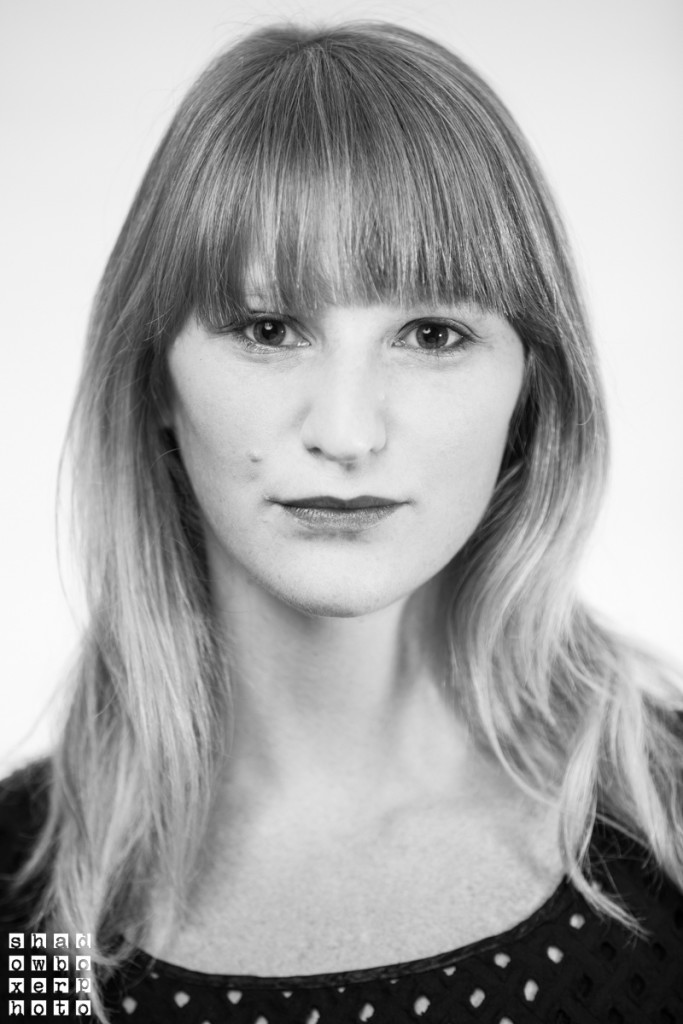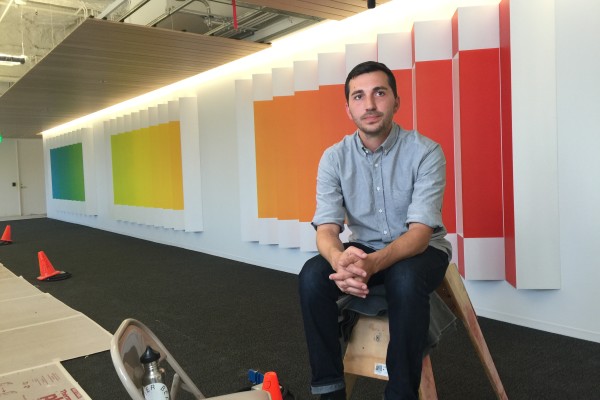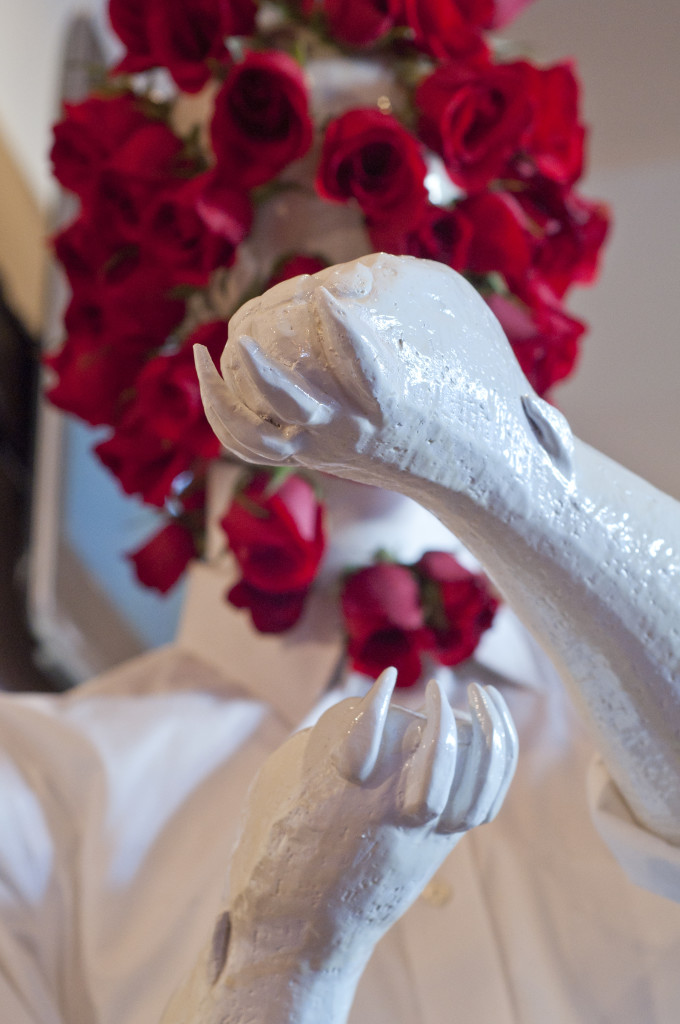 Last year, artist Romy Aura Maloon put out a call for Atlanta residents to help her sift through bags of synthetic flowers and form flower knitting circles for her Elevate ATL art installation, “Calibrate.” The nostalgic large-scale piece, featuring the SMPTE color bars from TVs in 1970s and 1980s, was hung over the side of a vacant building for the event. The spirit of collaboration as a power structure and her lack of control over the final product are what drew Maloon to this project—they’re also forces that drive most of her work.
Last year, artist Romy Aura Maloon put out a call for Atlanta residents to help her sift through bags of synthetic flowers and form flower knitting circles for her Elevate ATL art installation, “Calibrate.” The nostalgic large-scale piece, featuring the SMPTE color bars from TVs in 1970s and 1980s, was hung over the side of a vacant building for the event. The spirit of collaboration as a power structure and her lack of control over the final product are what drew Maloon to this project—they’re also forces that drive most of her work.
Currently a WonderRoot 2014-15 Walthall Artist Fellow, Maloon’s work mixes synthetic and organic materials, sometimes inspired by her work as an event coordinator at the Atlanta Contemporary Art Center. While her South African heritage is an important influence in her work, she has lately touched on the theme of mortality too, due to the death of a close friend—especially seen in her latest show at Beep Beep Gallery, “Epiphany is not a Blazing Light.” She has shown her work at galleries in Georgia and Florida, including the Atlanta Contemporary Art Center and Art Basel in Miami.
Here, Maloon discusses her heritage, working as an artist in Atlanta and her current show at Beep Beep Gallery.
CommonCreativ: So, how did you end up in Atlanta?
Romy Aura Maloon: My family emigrated to the States when I was born and moved to Georgia when I was 4 years old. I grew up in the northern suburb of Marietta. We came into the city when I was younger to go to concerts and museums, but I didn’t really have any knowledge of the art community here. I went to the Ringling College of Art and Design in Sarasota, Fla., mostly so I could make big sculptures by the beach, and then the New York Studio program, so I could make tiny sculptures in Brooklyn. After college, I moved back to Marietta and I lived there for a year before almost losing my mind to suburban malaise. Then I moved to Atlanta.
CC: Your parents emigrated from South Africa. How has your heritage influenced your work?
RM: I’m attracted to South African animal imagery—the lion, springbok, gemsbok. My parents owned African folk art, so I grew up looking at bead dolls, animal heads made of Coke cans and rough paintings of township landscapes. There is a real DIY sensibility and practical use of available material in this kind of work, which I believe has influenced my attraction to mixed media.
In addition to the literal imagery, I’m fascinated by the power structure of Apartheid and all subsequent systems of control. My parents grew up in an system that limited interactions between peoples and controlled media to do so. This element of institutional power and
control is fascinating to me.
In my installations, I use a very specific kind of gold towing chain. To me, this material is the ultimate representation of these systems of control; it’s beautiful and gold like decorative jewelry, but it is heavy and challenging to move—it can physically cause damage to someone or something.
CC: When did you first start working with mixed media and creating art?
RM: I never quite know how to answer this question. I’ve been making things as far back as I can remember; whether it was a silly doodle for my parents to put on their refrigerator or a makeshift treehouse to play in, I’ve always had my hands busy. In high school, I started painting because that’s what I learned “real artists” did. In college I learned there are many ways to get an image on a surface beyond painting. I realized that’s not where my interest lies. The possibilities of how to make something are infinite, a work can be intangible, digital, ephemeral, monolithic. In recent years, I’ve allowed the material to guide me more.
CC: You are currently part of the Walthall Fellowship—tell me about the work you’ve done there.
RM: Walthall has been a fantastic experience. I’ve met and become friends with some incredibly talented artists. It’s been so interesting to learn about everyone’s individual practice, especially dance and performance, which I know less about than visual mediums. It has really helped me understand that there are so many ways to be an artist. Everyone has a unique take on their professional practice; whether it’s gallery work, community oriented work, commercially oriented work, or raw and wild, each fellow has their own method.
We recently spent five days on Ossabaw Island off the coast of Savannah, Ga., together on a residency retreat. It was meaningful to get away and devote our time exclusively to making or thinking about making. On the island, I was very attracted to sites with charred trees burned to a crisp by lighting strikes. They seemed so desolate, yet petrified—part of a cycle. These trees were the impetus behind a new work in my current show at Beep Beep Gallery, wherein I built and then completely charred a hospital bed. I also collected animal skulls from Ossabaw, which became part of sculptures in that show. I am currently working on a large floral sculpture that will reconfigure an old work, something I like to do often, which will be in the Walthall exhibition at MOCA GA on July 18th.
CC: Tell me about the concept behind your “Epiphany” show at Beep Beep Gallery?
RM: The full title “Epiphany is not a Blazing Light,” is a line from a Martín Espada poem. The poem is about how death and life are not made up of huge milestones and epic experiences, but mostly small daily situations or in the case of death, a slow slip away as opposed to an epic battle. I was also thinking about how making a body of work is not a single burning brilliant idea for me, but rather a slow process of pulling together different elements. More personally, I very recently lost a very close friend of my age to cancer. Her untimely death was really a catalyst behind the recent work. I am thinking about the inability to control our own mortality, the constant cycle that keeps turning.
CC: So how do you explore the concept of mortality with synthetic flowers and other materials?
RM: I love working with flowers that never die. I read a wonderful Frida Kahlo quote recently that said something to the effect of, “I paint flowers so they will never die.” That idea is really strong to me. I like that their connotation can change depending on who’s looking at them. Some people view them as quintessential bad taste, other people would have them at their wedding. The flowers can abstract depending on the how you adhere them or can be used to make color fields.
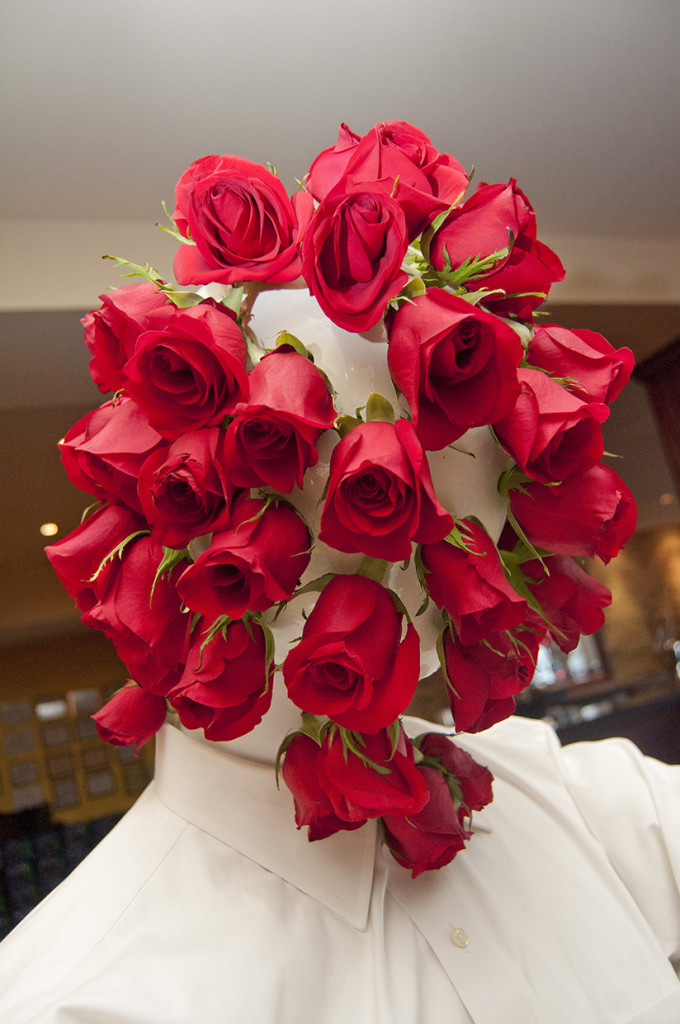 CC: Tell me about your use of organic vs. synthetic materials in your work. Do you have any favorite materials you like to work with aside from the flowers?
CC: Tell me about your use of organic vs. synthetic materials in your work. Do you have any favorite materials you like to work with aside from the flowers?
RM: I need the tension of items that will live forever, like fired ceramic or plastic flowers juxtaposed with live flowers, or trees and found bones. I enjoy working with ceramic because of the repetition you achieve through mold making, and I have a pretty good hand at it. I love working with gold towing chain, although it’s a love/hate relationship because conceptually I think it’s everything, but physically it is a pain in the ass to lug around. I think that is part of my attraction though, that it is physically hard to utilize. I like building with wood and did a lot of woodworking in college, I’m seeing that creep into my practice again.
CC: You also work as an event coordinator at the Atlanta Contemporary Art Center. How does that gig influence your work?
RM: I started working in hospitality after graduating from college when I fell into working for a catering company. I quickly realized the connection between creating site-specific installation work and site-specific event decor/buffet displays. I am attracted to the garish aesthetic of “event decor.” It shows up in my material choices, like using glitter or synthetic flowers. At the Contemporary, I spend a lot of time thinking about layouts and floor plans, which I always do when creating large-scale work. I think the logistical planning and project management that goes into my day job really informs my work as of late.
CC: What inspires you?
RM: I typically find an object that is a catalyst for a work or even a whole body. I’m not exactly sure what the element is that attracts me, but when I find something, it sticks. Sometimes I’ll hoard material or a specific item for months or even years before they come into play. Whether it’s a material like gold chain or netting or collecting charred tree bark on Ossabaw, which later became the inspiration for my hospital bed piece. I like to have a specific space or deadline for my art making, it helps me to know who my audience will be. I’m motivated knowing it will be seen. I also have a specific sense of how I like things to lay out. I always consider how the work sits in physical space even if that space is a white cube.
CC: Do you have any collaborations you’d like to see happen in the future?
RM: I just did a drawing/screenprint collaboration with my partner Evan and was very happy with how that turned out. I did a rough drawing of an image I’ve been repeating, then passed it on to Evan who inked it and burned it onto a screen to screen print. I mentioned my interest in systems of control—there’s something liberating about relinquishing control over a drawing and seeing how someone else finishes the process. I do this in my ceramic work in letting the kiln control the final product, or in my “Calibrate” project where the community physically made the work, really limiting my control. In terms of future collaborations, I don’t have anything specific lined up, but I imagine something will come out of my Walthall fellowship community.
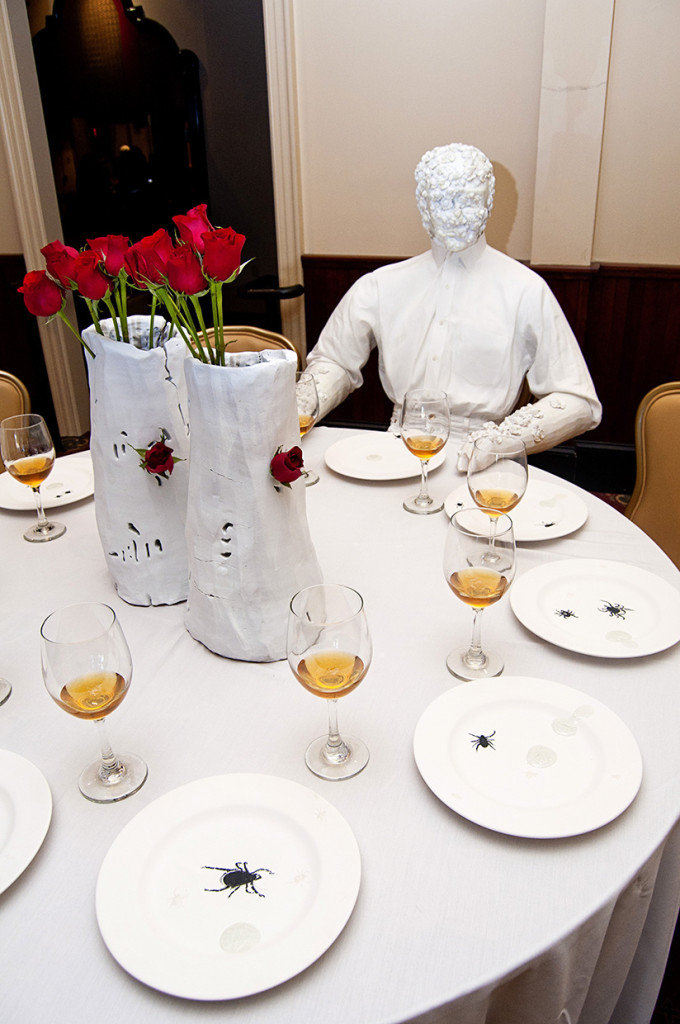 CC: What are your thoughts on Atlanta’s creative/maker scene?
CC: What are your thoughts on Atlanta’s creative/maker scene?
RM: Atlanta is fertile ground if you want it to be. There is a tight-knit, supportive community and plenty of space to explore that. In the short amount of time I’ve lived here, I have been able to become a part of numerous organizations whose work I admire, like Dashboard Co-op and the Atlanta Contemporary Art Center. I became a part of these institutions first by simply showing up; going to and volunteering at events with these spaces, which eventually lead to being hired. In order to participate in the gallery system, I think one needs to show in other cities, but I believe showing in other cities benefits Atlanta too; like Dashboard’s recent Detroit and upcoming New Orleans exhibitions. Here, there is ample opportunity to make public work, take over under used spaces, and carve out a space for yourself. In the last few years that I’ve lived here, there has been a surge of organizations that serve to help artists professionally, like C4 and WonderRoot. I use WonderRoot’s kiln for my ceramic work. Admittedly, it takes a little digging, but once you find that space there is a group of artists and makers who are enthusiastic about what they’re doing and happy to help. I think there’s a real spirit of collaboration as opposed to competition.
CC: Any other favorite organizations or projects in the city?
RM: I’m excited about Elevate Atlanta getting a big grant for larger funding to individual artists. I think Flux Projects is doing a great job of bringing some world renowned artists to the city, like they did with Nick Cave.
CC: What’s next for you?
RM: The Walthall Fellowship show “Portalism” is July 18th at MOCA GA, and I’m working on a large piece for that. I have a few applications out, but I won’t jinx myself by mentioning them. I intend to apply to more residencies so I can really focus on making. I’d also like to do another large scale public work, maybe a continuation of my “Calibrate” project in another city. I’m not sure, the sky’s the limit.
You can see more of Romy Aura Maloon’s work on her site or at her solo show at Beep Beep Gallery, on display now through June 20, when she’ll be giving an on-site artist talk at 2pm. More information here.

